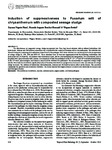Please use this identifier to cite or link to this item:
http://www.alice.cnptia.embrapa.br/alice/handle/doc/974582Full metadata record
| DC Field | Value | Language |
|---|---|---|
| dc.contributor.author | PINTO, Z. V. | pt_BR |
| dc.contributor.author | MORANDI, M. A. B. | pt_BR |
| dc.contributor.author | BETTIOL, W. | pt_BR |
| dc.date.accessioned | 2013-12-20T11:11:11Z | pt_BR |
| dc.date.available | 2013-12-20T11:11:11Z | pt_BR |
| dc.date.created | 2013-12-20 | pt_BR |
| dc.date.issued | 2013 | pt_BR |
| dc.identifier.citation | Tropical Plant Pathology, Brasília, DF, v. 38, n. 5, p. 414-422, 2013. | pt_BR |
| dc.identifier.uri | http://www.alice.cnptia.embrapa.br/alice/handle/doc/974582 | pt_BR |
| dc.description | Abstract: The effectiveness of composted sewage sludge incorporated into Pinus bark-based substrate with or without biofertilizer, fish hydrolyzate, chitosan and Trichoderma asperellum was evaluated for the control of Fusarium wilt in chrysanthemum. The substrate was obtained from pots containing chrysanthemum plants killed by the pathogen. Half of the substrate was sterilized prior to the incorporationof sewage sludge (0, 10%, 20% and 30% v/v). These substrates were or were not supplemented with the following: biofertilizer, fish hydrolyzate and Trichoderma. The mixtures were transferred to pots, and the chrysanthemum was transplanted. For all treatments, half of the plants were sprayed weekly with chitosan. Assessment of severity was performed on the 8th, 12th, 15th and 20th week after transplanting. In the 12th week, microbiological and chemical analysis of the substrate was performed. The incorporation of composted sewage sludge into the Pinus bark-based substrate significantly reduced Fusarium wilt, which was progressively decreased as the concentration of sewage sludge increased. The addition of biofertilizer, fish hydrolyzate, chitosan and Trichoderma had no effect on the disease. The microbial community was greater in non-disinfested substrates. The results indicate that suppressiveness is related to the interaction of chemical and microbiological factors. | pt_BR |
| dc.language.iso | eng | eng |
| dc.rights | openAccess | eng |
| dc.subject | Biosolid | pt_BR |
| dc.subject | Container media | pt_BR |
| dc.subject | Soil-borne pathogens | pt_BR |
| dc.title | Induction of suppressiveness to Fusarium wilt of chrysanthemum with composted sewage sludge. | pt_BR |
| dc.type | Artigo de periódico | pt_BR |
| dc.date.updated | 2013-12-20T11:11:11Z | pt_BR |
| dc.subject.nalthesaurus | Chrysanthemum morifolium | pt_BR |
| dc.subject.nalthesaurus | organic matter | pt_BR |
| riaa.ainfo.id | 974582 | pt_BR |
| riaa.ainfo.lastupdate | 2021-02-01 -02:00:00 | pt_BR |
| dc.contributor.institution | ZAYAME V. PINTO, CNPMA | eng |
| dc.contributor.institution | MARCELO AUGUSTO BOECHAT MORANDI, CNPMA | eng |
| dc.contributor.institution | WAGNER BETTIOL, CNPMA. | eng |
| Appears in Collections: | Artigo em periódico indexado (CNPMA)  | |
Files in This Item:
| File | Description | Size | Format | |
|---|---|---|---|---|
| 2013AP36.pdf | 18.92 MB | Adobe PDF |  View/Open |









